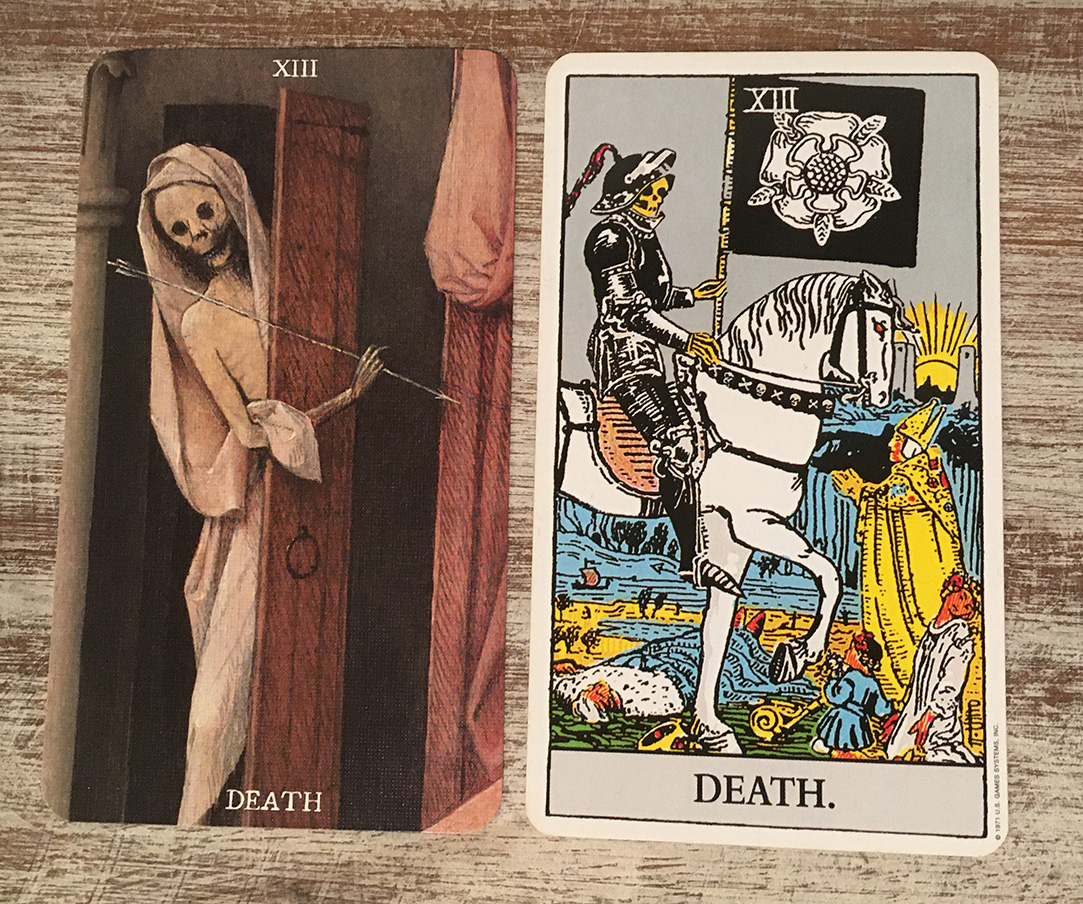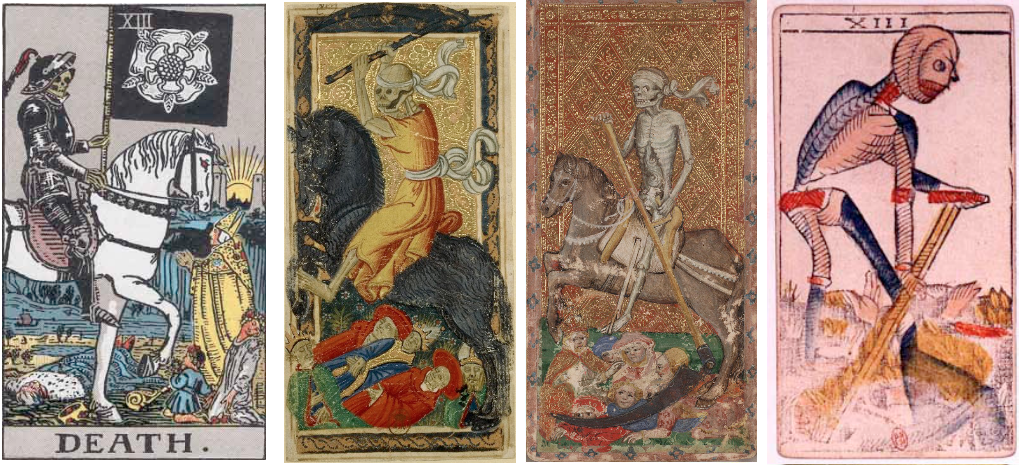13 (number)
13 (thirteen) is the natural number following 12 and preceding 14.
Folklore surrounding the number 13 appears in many cultures around the world: one theory is that this is due to the cultures employing lunar-solar calendars (there are approximately 12.41 lunations per solar year, and hence 12 "true months" plus a smaller, and often portentous, thirteenth month). This can be witnessed, for example, in the "Twelve Days of Christmas" of Western European tradition.
In a tarot card deck, XIII is the card of Death, usually picturing a skeletal figure.
History of superstition
The supposed unlucky nature of the number 13 has several theories of origin. Although several authors claim it is an older belief, no such evidence has been documented so far. In fact, the earliest attestation of 13 being unlucky is first found after the Middle Ages in Europe.
Since at least 1774, a superstition of "thirteen at a table" has been documented: if 13 people sit at a table, then one of them must die within a year. The origin of the superstition is unclear and various theories of its source have been presented over the years.
In some regions, 13 is (or has been) considered a lucky number. Prior to the First World War, 13 was considered to be a lucky number in France, even being featured on postcards and charms.
Myth of Hammurabi's code
There is a myth that the earliest reference to thirteen being unlucky or evil is in the ancient Babylonian Code of Hammurabi (circa 1780 BC), where the thirteenth law is said to be omitted. In fact, the original Code of Hammurabi has no numeration. The translation by L.W. King (1910), edited by Richard Hooker, omitted one article: "If the seller have gone to (his) fate (i. e., have died), the purchaser shall recover damages in said case fivefold from the estate of the seller."
Abrahamic Religions
Judaism
In Judaism, 13 signifies the age at which a boy matures and becomes a Bar Mitzvah, i.e., a full member of the Jewish faith (counts as a member of Minyan). It is also the number of principles of Jewish faith according to Maimonides.
According to Rabbinic commentary on the Torah, God has 13 Attributes of Mercy.
Christianity
All branches of Christianity agree that Jesus Christ had 12 disciples, thus forming a group of 13.
The apparitions of the Virgin of Fátima in 1917 occured on the 13th day of six consecutive months.
In Catholic devotional practice, the number thirteen is also associated with Saint Anthony of Padua, since his feast day falls on June 13. A traditional devotion called the Thirteen Tuesdays of St. Anthony involves praying to the saint every Tuesday over a period of thirteen weeks. Another devotion, St. Anthony's Chaplet, consists of thirteen decades of three beads each.
The Last Supper
At Jesus Christ's Last Supper, there were thirteen people around the table, counting Christ and the twelve apostles. Some believe this is unlucky because one of those thirteen, Judas Iscariot, was the betrayer of Jesus Christ. From the 1890s, a number of English language sources relate the "unlucky" thirteen to an idea that at the Last Supper, Judas, the disciple who betrayed Jesus, was the 13th to sit at the table.
Knights Templar
On Friday, 13 October 1307, King Philip IV of France ordered the arrest of the Knights Templar, and most of the knights were tortured and killed.
Islam
In Shia Islam, 13 signifies the 13th day of the month of Rajab (the Lunar calendar), which is the birth of Imam Ali. 13 also is a total of 1 Prophet and 12 Shia Imams in the Islamic School of Thought.
Other religions
Zoroastrianism
Since beginning of the Nowruz tradition, the 13th day of each new Iranian year is called Sizdah Be-dar, a festival dedicated to pranks and spending time outdoors.
Pre-columbian mythology
According to Aztec mythology, the Thirteen Heavens were formed by the gods from the head of Cipactli during creation.
In the Mayan Tzolk'in calendar, trecenas mark cycles of 13-day periods. The pyramids are also set up in 9 steps divided into 7 days and 6 nights, 13 days total.
Wicca
A common tradition in Wicca holds that the number of members for a coven is ideally thirteen, though this tradition is not universal.
Astronomy
In astronomy there are 13 star constellations in the zodiac (including Ophiuchus); this can be compared with astrology where there are 12 signs of the zodiac.
Full moons
A year with 13 full moons instead of 12 posed problems for the monks in charge of the calendars. This was considered a very unfortunate circumstance, especially by the monks who had charge of the calendar of thirteen months for that year, and it upset the regular arrangement of church festivals. For this reason, thirteen came to be considered an unlucky number. However, a typical century has about 37 years that have 13 full moons, compared to 63 years with 12 full moons, and typically every third or fourth year has 13 full moons.
In the tarot
Tarot card games have been attested since at least around 1450 with the Visconti-Sforza Tarot. One of the trump cards in tarot represents Death, and is numbered 13 in several variants.
In 1781, Antoine Court de Gébelin writes of this card's presence in the Tarot of Marseilles that the number thirteen was "toujours regarde comme malheureux" ("always considered as unlucky"). In 1784, Johann Gottlob Immanuel Breitkopf cites Gébelin, and reaffirms that the tarot card number 13 is death and misfortune ("Der Tod, Unglück").
The 13th floor
The thirteenth floor is often omitted in countries where the number 13 is considered unlucky. Omitting the 13th floor may take a variety of forms, but the most common include denoting what would otherwise be considered the thirteenth floor as level 14, giving the thirteenth floor an alternative designation such as "12A" or "M" (the thirteenth letter of the Latin alphabet), or closing the 13th floor to public occupancy or access (e.g., by designating it as a mechanical floor).
This concept was used as a plot device in the 1990 occult horror film Nightmare on the 13th Floor.
Research
In a 2007 Gallup poll, 13 percent of American adults reported that they would be bothered if given a hotel room on the thirteenth floor, while 9 percent indicated that they would be sufficiently bothered to request a room on a different floor.

